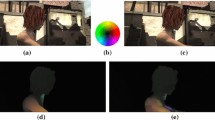Abstract
We propose a new algorithm for dense optical flow computation. Dense optical flow schemes are challenged by the presence of motion discontinuities. In state of the art optical flow methods, over-smoothing of flow discontinuities accounts for most of the error. A breakthrough in the performance of optical flow computation has recently been achieved by Brox et~al. Our algorithm embeds their functional within a two phase active contour segmentation framework. Piecewise-smooth flow fields are accommodated and flow boundaries are crisp. Experimental results show the superiority of our algorithm with respect to alternative techniques. We also study a special case of optical flow computation, in which the camera is static. In this case we utilize a known background image to separate the moving elements in the sequence from the static elements. Tests with challenging real world sequences demonstrate the performance gains made possible by incorporating the static camera assumption in our algorithm.
Similar content being viewed by others
References
Ambrosio, L. and Tortorelli, V.M. 1990. Approximation of functionals depending on jumps by elliptic functionals via γ-Convergence. Comm. Pure and Applied Mathematics, 43:999–1036.
Amiaz T. and Kiryati, N. 2005. Dense discontinuous optical flow via contour-based segmentation. In Proc. IEEE International Conference on Image Processing (ICIP'2005), III, Genova, Italy, pp. 1264–1267.
Anandan, P. 1989. A computational framework and an algorithm for the measurement of visual motion. Int. J. Computer Vision, 2:283–310.
Andrews, R.J. and Lovell, B.C. 2003. Color optical flow. In Proc. Workshop Digital Image Computing, Brisbane, pp. 135–139.
Aubert, G. and Kornprobst, P. 2002. Mathematical Problems in Image Processing. Springer.
Bar, L., Rochel, S., and Kiryati, N. January 2005. TAU-DANCE: Tel-Aviv University Multiview and Omnidirectional Video Dance Library, VIA - Vision and Image Analysis Laboratory, School of Electrical Engineering, Tel Aviv University.
Barron, J.L., Fleet, D.J., and Beauchemin, S.S. 1994. Performance of optical flow techniques. Int. J. Computer Vision, 12:43–77.
Black, M.J. and Anandan, P. 1996. The robust estimation of multiple motions: Parametric and piecewise smooth flow fields. Computer Vision and Image Understanding, 63:75–104.
Black, M.J. and Fleet, D.J. 2000. Probabilistic Detection and Tracking of Motion Boundaries. Int. J. Computer Vision, 38:231–245.
Borshukov, G.D., Bozdagi, G., Altunbasak, Y., and Tekalp, A.M. 1997. Motion segmentation by multistage affine classification. IEEE Trans. Image Processing, 6:1591–1594.
Brownrigg, D.R.K. 1984. The Weighted Median Filter. Commun. ACM, 27:807–818.
Brox, T., Bruhn, A., Papenberg, N., and Weickert, J. 2004. High accuracy optical flow estimation based on a theory for warping. In Proc. 8th European Conf. Computer Vision, Part IV: Lecture Notes in Coputer Science, vol. 3024, pp. 25–36.
Bruhn, A., Weickert, J., Kohlberger, T., and Schnörr, C. 2005. Discontinuity-preserving computation of variational optic flow in real-time, In Proc. Scale-Space 2005: Lecture Notes in Computer Science, vol. 3459, pp. 279–290.
Cremers, D. and Soatto, S. 2005. Motion competition: A variational approach to piecewise parametric motion segmentation. Int. J. Computer Vision, 62:249–265.
Dervieux, A. and Thomasset, F. 1979. A finite element method for the simulation of Rayleigh-Taylor instability. Lecture Notes in Mathematics, 771:145–158.
Fleet, D.J. and Jepson, A.D. 1990. Computation of component image velocity from local phase information. Int. J. Computer Vision, 5:77–104.
Galvin, B., McCane, B., Novins, K., Mason, D., and Mills, S. 1998. Recovering motion fields: An evaluation of eight optical flow algorithms. In Proc. British Machine Vision Conference, Southampton, UK.
Horn, B. and Schunck, B. 1981. Determining optical flow. Artificial Intelligence, 17:185–203.
Irani, M. and Peleg, S. 1993. Motion Analysis for Image Enhancement: Resolution, Occlusion and Transparency. J. Visual Comm. Image Representation, 4:324–335.
Kollnig, H., Nagel, H.H., and Otte, M. 1994. Association of motion verbs with vehicle movements extracted from Dense optical flow fields. Lecture Notes in Computer Science, 801:338–347.
Lucas, B. and Kanade, T. 1981. An iterative image registration technique with application to stereo vision. In Proc. DARPA Image Understanding Workshop, pp. 121–130.
Mémin, E. and Pérez, P. 1998. A Multigrid Approach for Hierarchical Motion Estimation. In Proc. 6th Int. Conf. Computer Vision, Bombay, India, pp. 933–938.
Mumford, D. and Shah, J. 1989. Optimal approximation by piecewise smooth functions and associated variational problems. Comm. Pure and Applied Mathematics, 42:577–685.
Nesi, P. 1993. Variational Approach to Optical Flow Estimation Managing Discontinuities. Image and Vision Computing, 11:419–439.
Osher, S. and Sethian, J.A. 1988. Fronts propagating with curvature dependent speed: Algorithms based on Hamilton-Jacobi formulation. J. Computational Physics, 79:12–49.
Paragios, N. and Deriche, R. 2005. Geodesic Active Regions and Level Set Methods for Motion Estimation and Tracking. Computer Vision and Image Understanding, 97:259–282.
Spies, H., Jähne, B., and Barron, J.L. 2002. Range flow estimation. Computer Vision and Image Understanding, 85:209–231.
Vese, L.A. and Chan, T.F. 2002. A multiphase level set framework for image segmentation using the Mumford and Shah model. Int. J. Computer Vision, 50:271–293.
Wang, J.Y.A. and Adelson, E.H. 1994. Representing Moving Images Images with Layers. IEEE Trans. Image Processing, 3:625–638.
Weickert, J. and Schnörr, C. 2001. Variational optic flow computation with a spatiotemporal smoothness constraint. J. Math. Imaging and Vision, 14:245–255.
Author information
Authors and Affiliations
Corresponding author
Rights and permissions
About this article
Cite this article
Amiaz, T., Kiryati, N. Piecewise-Smooth Dense Optical Flow via Level Sets. Int J Comput Vision 68, 111–124 (2006). https://doi.org/10.1007/s11263-005-6206-0
Received:
Revised:
Accepted:
Published:
Issue Date:
DOI: https://doi.org/10.1007/s11263-005-6206-0




